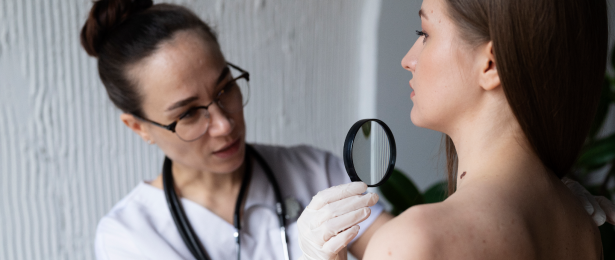Inflammatory breast cancer (IBC) and skin infections can both manifest with skin changes, including rashes, redness, and swelling. However, it is essential to recognize the crucial differences between these two conditions, as they require vastly different approaches to diagnosis, treatment, and prognosis.
I. Inflammatory Breast Cancer Rash
Clinical Characteristics:
Inflammatory breast cancer is a rare but aggressive form of breast cancer that often presents with a distinctive rash. The key characteristics of an IBC rash include:
- Rapid onset: The rash typically develops over a short period, sometimes in a matter of weeks or even days.
- Persistent redness: The skin on the breast becomes red, warm, and swollen, resembling an inflammation.
- Peau d'orange: The skin may develop a dimpled or textured appearance, similar to an orange peel.
- Breast enlargement and tenderness: The affected breast may become larger and feel tender to touch.
- Absence of a visible lump: Unlike many other breast cancers, IBC often does not produce a palpable lump.
Risk Factors:
The exact cause of IBC remains unclear, but several risk factors are associated with its development:
- Gender: IBC can affect both men and women, although it is more common in women.
- Age: IBC tends to occur at a younger age than other types of breast cancer.
- Family history: A family history of breast cancer may increase the risk.
- Race: African American women are at a slightly higher risk of IBC compared to other racial groups.
Diagnosis:
Diagnosing IBC requires a combination of clinical evaluation and medical imaging. Key diagnostic steps include:
- Physical examination: A healthcare provider examines the breast and skin changes.
- Biopsy: A tissue sample is taken from the affected area to confirm the presence of cancer cells.
- Imaging tests: Mammography, ultrasound, or MRI scans help assess the extent of cancer.
Treatment:
IBC is a highly aggressive cancer, and prompt treatment is essential. Treatment options typically include:
- Chemotherapy: To shrink the tumor and control cancer spread.
- Surgery: Mastectomy is often recommended to remove the affected breast.
- Radiation therapy: To target remaining cancer cells after surgery.
- Targeted therapy: Medications that target specific molecules involved in cancer growth.
Symptoms:
Inflammatory breast cancer (IBC) is characterized by rapid onset and distinctive symptoms, often without a palpable lump. Symptoms of Inflammatory breast cancer include:
- Persistent Redness: The breast becomes red, pink, or purplish, covering a significant area.
- Swelling and Enlargement: The affected breast may appear larger, swollen, and feel heavier.
- Warmth and Tenderness: The breast feels warm to the touch and can be tender or painful.
- Nipple Changes: Nipple inversion or discharge may occur.
- Breast Firmness: The breast feels unusually firm.
- Axillary Swelling: Swollen lymph nodes in the armpit or collarbone area may be noticeable.
II. Skin Infections
Clinical Characteristics:
Skin infections encompass a wide range of conditions caused by bacteria, fungi, viruses, or parasites. Common characteristics of skin infections include:
- Rash or redness: Infections can cause localized or widespread rashes on the skin.
- Pain or itching: Affected areas may be painful, itchy, or both.
- Swelling: In some cases, there may be swelling at the site of infection.
- Pus or discharge: Infections may produce pus, fluid, or crust.
Risk Factors:
The risk factors for skin infections can vary depending on the specific pathogen involved. Common risk factors include:
- Poor hygiene: Inadequate cleaning of the skin can increase the risk of infection.
- Compromised immune system: Individuals with weakened immune systems are more susceptible.
- Skin trauma: Cuts, abrasions, or skin conditions like eczema can provide entry points for pathogens.
Diagnosis:
Diagnosing a skin infection involves a combination of clinical evaluation and, in some cases, laboratory tests. Diagnostic steps may include:
- Physical examination: A healthcare provider assesses the appearance of the rash and other symptoms.
- Microbial cultures: In some cases, a sample from the affected area is cultured to identify the specific pathogen.
- Blood tests: Blood tests can help determine if the infection has spread to the bloodstream.
Treatment:
The treatment of skin infections depends on the underlying cause and may include:
- Antibiotics: Bacterial infections are typically treated with antibiotics.
- Antifungal medications: Fungal infections require antifungal drugs.
- Antiviral medications: Viral infections are treated with antiviral drugs.
- Symptomatic relief: Over-the-counter creams or ointments can alleviate symptoms like itching or pain.
Conclusion
Inflammatory breast cancer rash and skin infections share some common features, such as redness and swelling of the skin. However, they are fundamentally different conditions with distinct risk factors, diagnostic approaches, and treatment strategies. While a skin infection is usually treatable and manageable, inflammatory breast cancer is a highly aggressive malignancy that requires urgent medical attention. Therefore, it is crucial for healthcare providers and patients to be aware of these differences to ensure timely diagnosis and appropriate intervention. If you notice any concerning changes in your breast or skin, it is always advisable to consult a healthcare professional for a thorough evaluation and diagnosis.
